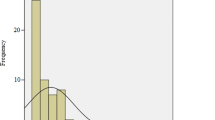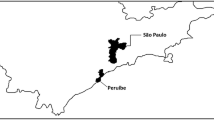Abstract
This paper presents a gamma spectrometric analysis of 47 samples of building materials produced and used in Serbia. Based on the measured activity concentrations of 226Ra, 232Th, and 40K, radiological hazard indices and annual effective doses were estimated for human exposure in the rooms. The values of radon surface exhalation rate and indoor radon concentration, as well as the range of indoor radon exposures for typical building materials produced in Serbia (concrete, mortar, clay bricks, granite, siporex, ceramic and concrete tiles), were estimated. Measurements of the dose rate for building materials in one typical home in Serbia were performed in contact geometry using the radiation monitor Radiagem 2000.


Similar content being viewed by others
References
Joshua EO, Ademola JA, Akpanowo MA, Oyebanjo OA, Olorode DO (2009) Natural radionuclides and hazards of rock samples collected from Southeastern Nigeria. Radiat Meas 44:401–404. https://doi.org/10.1016/j.radmeas.2009.04.002
Markkanen M (1995) Radiation dose assessments for materials with elevated natural radioactivity. Finnish Centre for Radiation and Nuclear Safety STUK-B-STO 32, Helsinki
Todorović N, Bikit I, Krmar M, Mrdja D, Hansman J, Nikolov J, Forkapić S, Vesković M, Bikit K, Jakonić I (2014) Natural radioactivity in raw materials used in building industry in Serbia. Int J Environ Sci Technol 12:705–716. https://doi.org/10.1007/s13762-013-0470-2
UNSCEAR (1993) Sources, effects and risks of ionizing radiation. United Nations Scientific Committee on the Effects of Atomic Radiation, United Nations New York
Del Claro F, Paschuk SA, Corrêa JN, Denyak V, Kappke J, Perna AFN, Martins MR, Santos TO, Rocha Z, Schelin HR (2017) Radioisotopes present in building materials of workplaces. Radiat Phys Chem 140:141–145. https://doi.org/10.1016/j.radphyschem.2017.02.037
Sharaf JM, Hamideen MS (2013) Measurement of natural radioactivity in Jordanian building materials and their contribution to the public indoor gamma dose rate. Appl Radiat Isot 80:61–66. https://doi.org/10.1016/j.apradiso.2013.06.016
Turhan Ş, Arıkan İH, Demirel H, Güngör N (2011) Radiometric analysis of raw materials and end products in the Turkish ceramics industry. Radiat Phys Chem 80:620–625. https://doi.org/10.1016/j.radphyschem.2011.01.007
Al-Jarallah M (2001) Radon exhalation from granites used in Saudi Arabia. J Environ Radioact 53:91–98. https://doi.org/10.1016/S0265-931X(00)00110-7
Anjos RM, JuriAyub J, Cid AS, Cardoso R, Lacerda T (2011) External gamma-ray dose rate and radon concentration in indoor environments covered with Brazilian granites. J Environ Radioact 102:1055–1061. https://doi.org/10.1016/j.jenvrad.2011.06.001
Ravikumar P, Somashekar RK (2013) Estimates of the dose of radon and its progeny inhaled inside buildings. Eur J Environ Sci 3:88–95. https://doi.org/10.14712/23361964.2015.10
Al-Azmi D, Okeyode IC, Alatise OO, Mustapha AO (2018) Setup and procedure for routine measurements of radon exhalation rates of building materials. Radiat Meas 112:6–10. https://doi.org/10.1016/j.radmeas.2018.03.001
Porstendorfer J (1994) Properties and behaviour of radon and thoron and their decay products in the air. J Aerosol Sci 25:219–263. https://doi.org/10.1016/0021-8502(94)90077-9
Schroeyers W (2017) Naturally occurring radioactive materials in construction—integrating radiation protection in reuse (COST Action Tu1301 NORM4BUILDING). Woodhead Publishing, Cambridge. https://doi.org/10.1016/C2016-0-00665-4
International Atomic Energy Agency (1989) Measurement of radionuclides in food and the environment, technical reports series No. 295, Vienna, Austria
Kuzmanović P, Todorović N, Forkapić S, Filipović Petrović L, Knežević J, Nikolov J, Miljević B (2019) Radiological characterization of phosphogypsum produced in Serbia. Radiat Phys Chem 166:108463. https://doi.org/10.1016/j.radphyschem.2019.108463
Todorović N, Forkapić S, Bikit I, Mrdja D, Vesković M, Todorović S (2011) Monitoring for exposures to TENORM Sources in Vojvodina region. Radiat Prot Dosim 144:655–658. https://doi.org/10.1093/rpd/ncq414
Kuzmanović P, Todorović N, Nikolov J, Hansman J, Vraničar A, Knežević J, Miljević B (2019) Assesment of radiation risk and radon exhalation rate for granite used in the construction industry. J Radioanal Nucl Chem 321:565–577. https://doi.org/10.1007/s10967-019-06592-9
Moens L, Donder JD, Xi-lei L, Corte FD, Wispelaere AD, Simonits A, Hoste J (1981) Calculation of the absolute peak efficiency of gamma-ray detectors for different counting geometries. Nucl Instr Methods 187:451–472. https://doi.org/10.1016/0029-554X(81)90374-8
Beretka J, Mathew PJ (1985) Natural radioactivity of Australian building materials, industrial waste sand by-products. Health Phys 48:87–95
NEA-OECD (Organization for Economic Co-operation and Development) (1979) Exposure to radiation from radioactivity in building materials. Report by a Group of Experts of The OECD Nuclear Energy Agency
European Commission (1999) Radiation protection 112—radiological protection principles concerning the natural radioactivity of building materials. Directorate—General Environment, Nuclear Safetyand Civil Protection. EC, Luxenbourg
Council Directive 2013/59/Euratom of 5 Dec. 2013 (2014) Laying down basic safety standards for protection against the dangers arising from exposure to ionising radiation, and repealing directives 89/618/Euratom, 90/641/Euratom, 96/29/Euratom, 97/43/Euratom and 2003/122/Euratom. L13, vol 57. ISSN 1977-0677. https://ec.europa.eu/energy/sites/ener/files/documents/CELEX-32013L0059-EN-TXT.pdf
UNSCEAR (2000) Sources and effects of ionizing radiation. United Nations Scientific Committee on Effects of Atomic Radiation. Exposures from Natural Radiation Sources, Annex B. United Nations Publication, New York, USA
UNSCEAR (2008) Sources and effects of ionizing radiation. Report to the General Assembly with Scientific Annexes, United Nations Scientific Committee on the Effects of Atomic Radiation, Annex A and B, United Nations, New York, USA
Official Gazette RS 36/18 (2018) Regulation on limits of radionuclide content in drinking water, foodstuffs, feeding stuffs, drugs, items of general use, building materials and other goods to be placed on the market (in Serbian)
Awhida A, Ujić P, Vukanac I, Ðurasević M, Kandić A, Čeliković I, Lončar B, Kolarž P (2016) Novel method of measurement of radon exhalation from building materials. J Environ Radioact 164:337–343. https://doi.org/10.1016/j.jenvrad.2016.08.009
Pacheco-Torgal F, Jalali S, Fucic A (2012) Toxicity of building materials. Woodhead Publishing Limited, Cambridge
Janik M, Omori Y, Yonehara H (2015) Influence of humidity on radon and thoron exhalation rates from building materials. Appl Radiat Isot 95:102–107. https://doi.org/10.1016/j.apradiso.2014.10.007
Abdullahi S, Ismail AF, Samat S (2019) Determination of indoor doses and excess lifetime cancer risks caused by building materials containing natural radionuclides in Malaysia. Nucl Eng Technol 51:325–336. https://doi.org/10.1016/j.net.2018.09.017
Aykamis AS, Turhan S, Uguret FA, Baykan UN, Kilic AM (2013) Natural radioactivity, radon exhalation rates and indoor radon concentration of some granite samples used as construction material in Turkey. Radiat Prot Dosim 157:105–111. https://doi.org/10.1093/rpd/nct110
USEPA (2016) US Environmental Protection Agency—a citizen’s guide to radon. The Guide to Protecting Yourself and Your Family from Radon, EPA402/K-12/002, USA https://www.epa.gov/sites/production/files/2016-12/documents/2016_a_citizens_guide_to_radon.pdf
World Health Organization, Zeeb H, Shannoun F (2009) Handbook on indoor radon: a public health perspective. World Health Organization. WHO Library Cataloguing-in-Publication Data, Geneva
International Commission on Radiological Protection (2017) Occupational intakes of radionuclides: part 3. ICRP Publication 137, Ann ICRP 46(3–4)
Manić V, Manić G, Nikezić D, Krstić D (2012) Calculation of dose rate conversion factors for 238U, 232Th and 40K in concrete structures of various dimensions, with application to Niš, Serbia. Radiat Prot Dosim 152:361–368. https://doi.org/10.1093/rpd/ncs058
Righi S, Bruzzi L (2006) Natural radioactivity and radon exhalation in building materials used in Italian dwellings. J Environ Radioact 88:158–170. https://doi.org/10.1016/j.jenvrad.2006.01.009
Damla N, Cevik U, Kobya AI, Celik A, Celik N, Yıldırım I (2011) Assessment of natural radioactivity and mass attenuation coefficients of brick and roofing tile used in Turkey. Radiat Meas 46:701–708. https://doi.org/10.1016/j.radmeas.2011.06.004
Todorovic N, Bikit I, Veskovic M, Krmar M, Mrđa D, Forkapic S, Hansman J, Nikolov J, Bikit K (2013) Radioactivity in the indoor building environment in Serbia. Radiat Prot Dosim 158:208–215. https://doi.org/10.1093/rpd/nct210
Medhat ME (2009) Assessment of radiation hazards due to natural radioactivity in some building materials used in Egyptian dwellings. Radiat Prot Dosim 133:177–185. https://doi.org/10.1093/rpd/ncp032
Narloch DC, Paschuk SA, Correa JN, Rocha Z, Mazer W, Montenegro Peddis Torres CA, Del Claro F, Denyak V, Reuters Schelin H (2019) Characterization of radionuclides present in portland cement, gypsum and phosphogypsum mortars. Radiat Phys Chem 155:315–318. https://doi.org/10.1016/j.radphyschem.2018.07.011
Bikit I, Mrda D, Grujic S, Kozmidis-Luburic U (2011) Granulation effects on the radon emanation rate. Radiat Prot Dosim 145:184–188. https://doi.org/10.1093/rpd/ncr055
Acknowledgements
The authors thank the Ministry of Education, Science and Technological Development of the Republic of Serbia for financial support for the realization of this work in the framework of scientific Projects No. 171002 and 43002.
Author information
Authors and Affiliations
Corresponding author
Ethics declarations
Conflict of interest
The authors declare that they have no conflict of interest.
Additional information
Publisher's Note
Springer Nature remains neutral with regard to jurisdictional claims in published maps and institutional affiliations.
Rights and permissions
About this article
Cite this article
Kuzmanović, P., Todorović, N., Filipović Petrović, L. et al. Radioactivity of building materials in Serbia and assessment of radiological hazard of gamma radiation and radon exhalation. J Radioanal Nucl Chem 324, 1077–1087 (2020). https://doi.org/10.1007/s10967-020-07130-8
Received:
Published:
Issue Date:
DOI: https://doi.org/10.1007/s10967-020-07130-8




